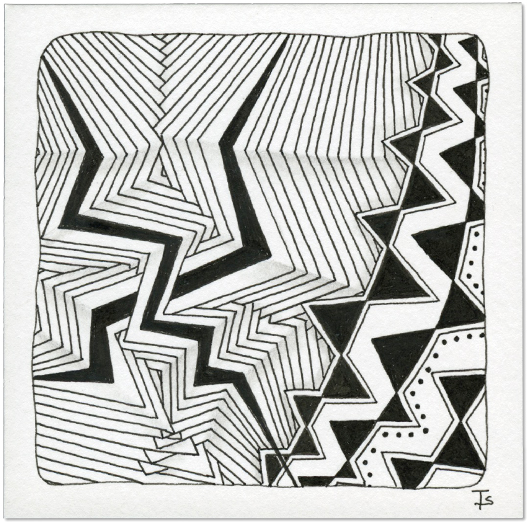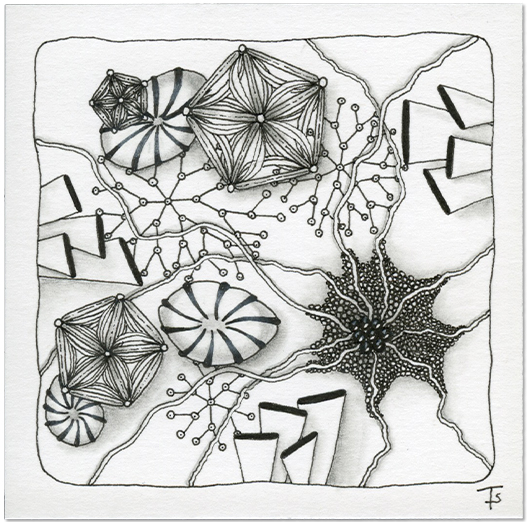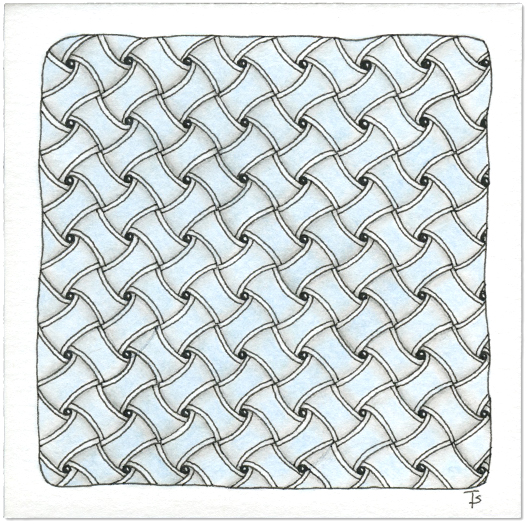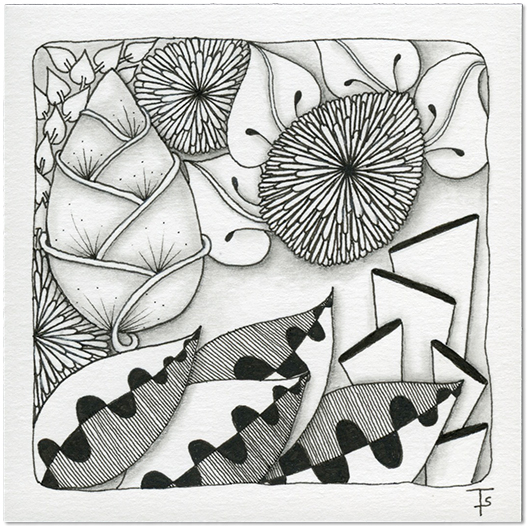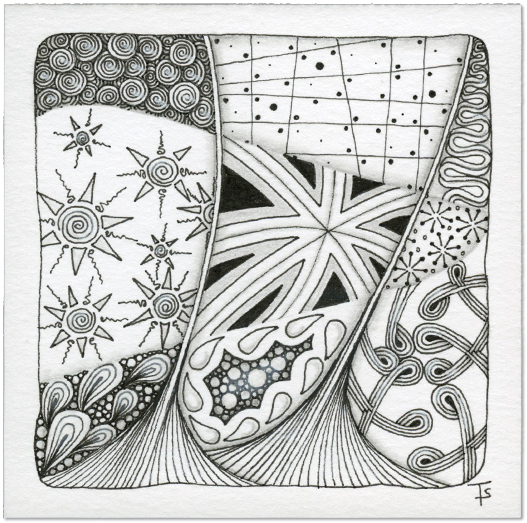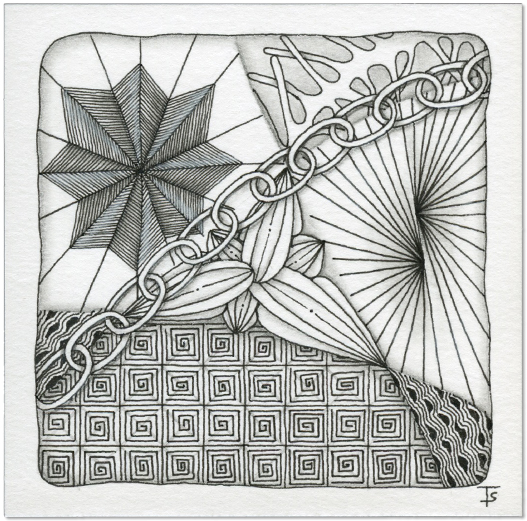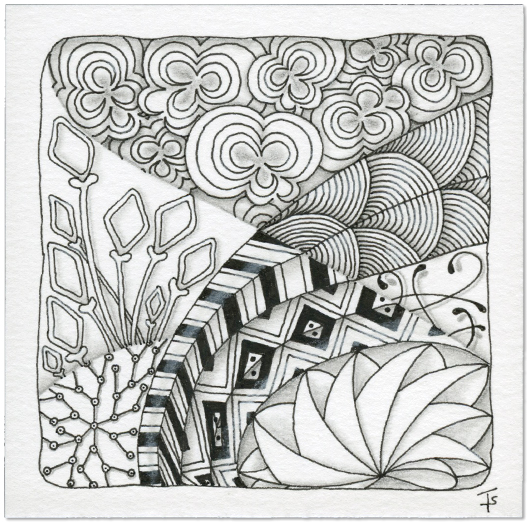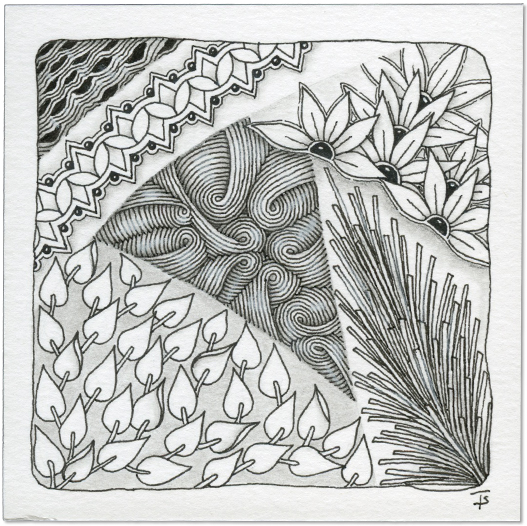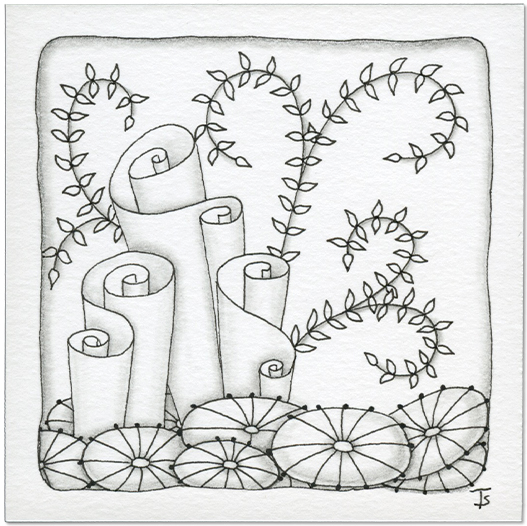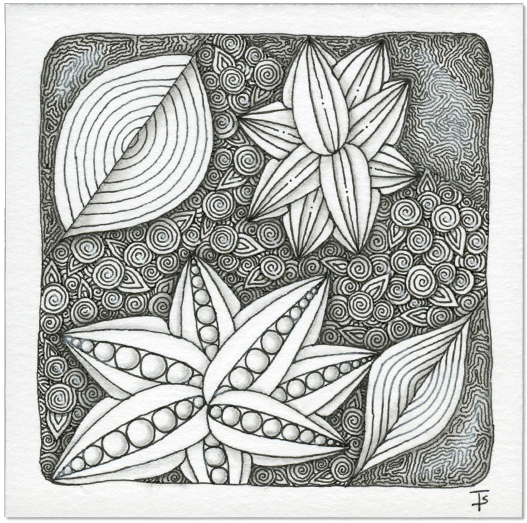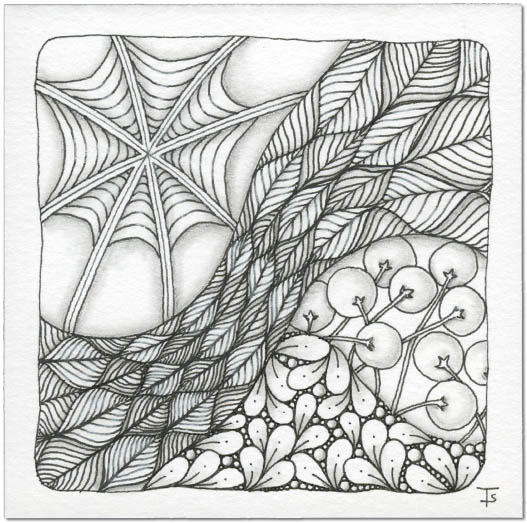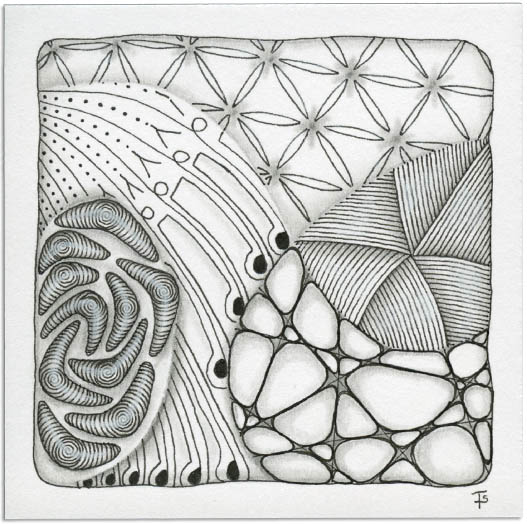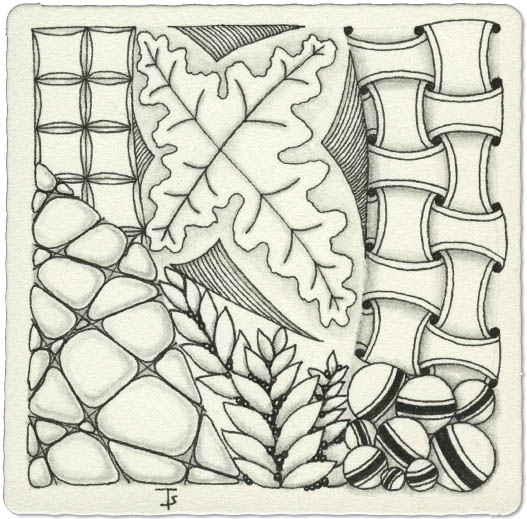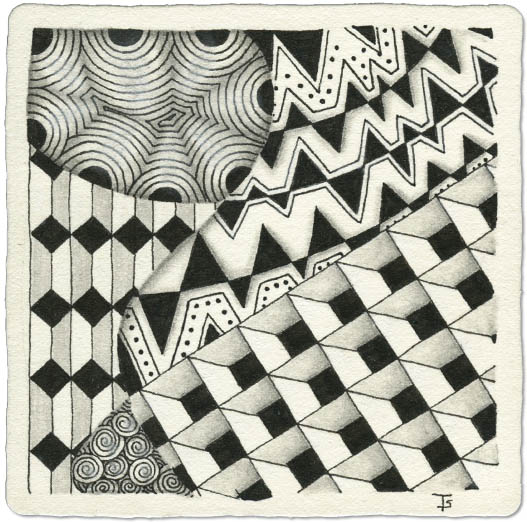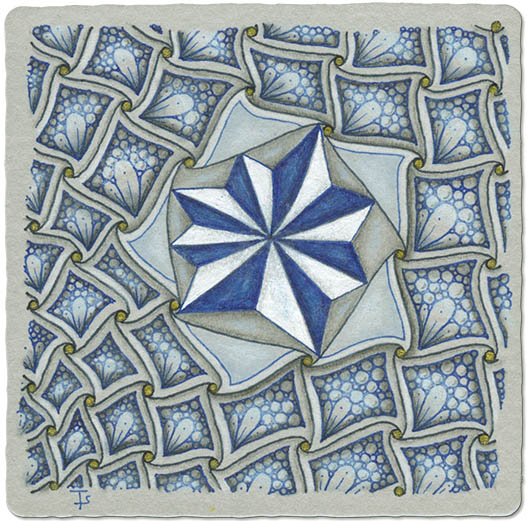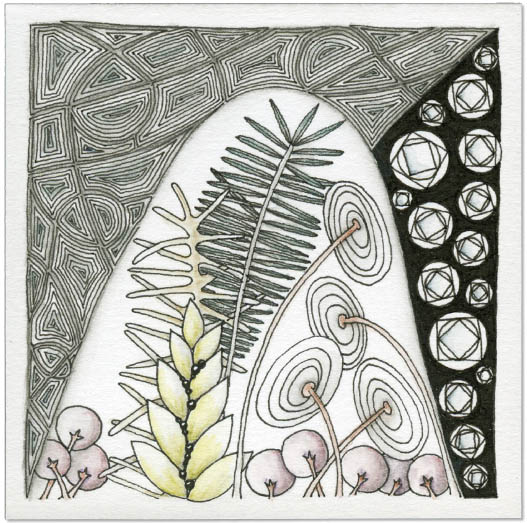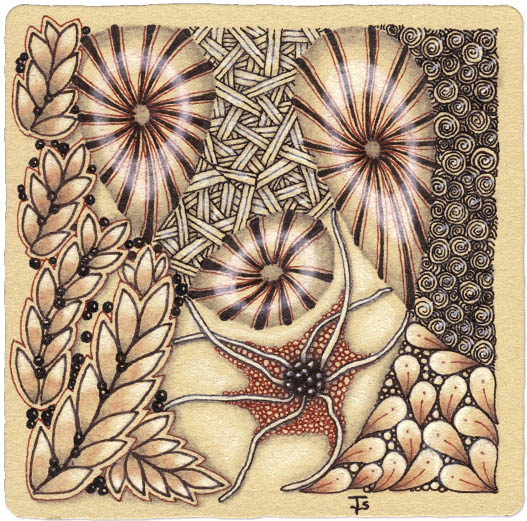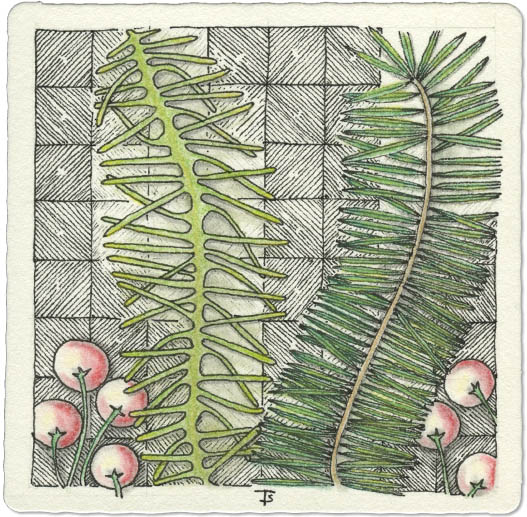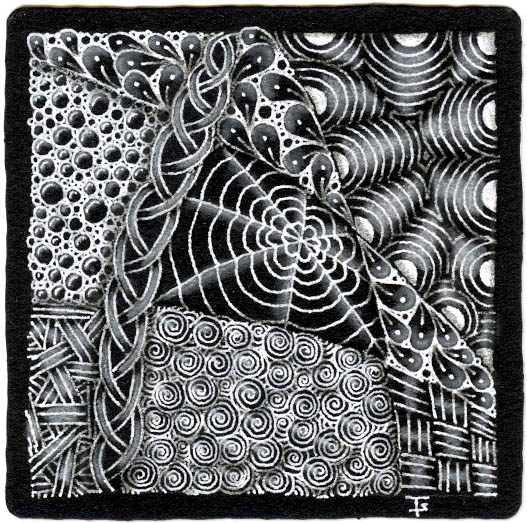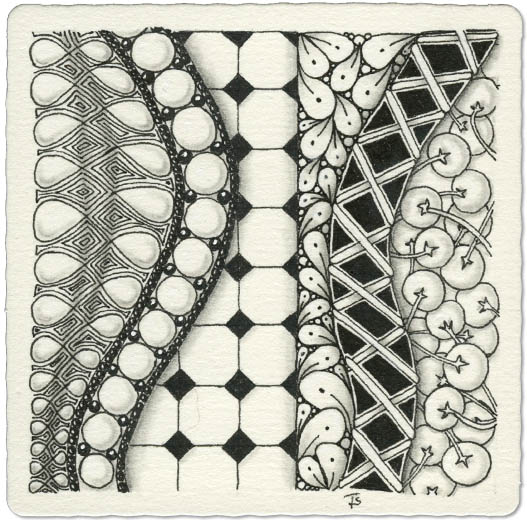No string, specifically chosen tangles.
Over the weekend, we had some pretty bad storms. Lots and lots of lightning, wind, hail and heavy rain.
We lost power for many hours because the power poles, about a block away, fell down during one of the wind events.
When that happens, I can’t work in my studio or office because it is too dark. I can’t post anything because… no computer, which is not a surprise. In my case, I aslo have no phone because I live in a “cellular hole”. That’s also not a surprise, since my phone never works at my house!
No string, random tangles.
Squid was the first tangle that came up randomly, so I decided to go without a string, using the “arms” of Squid for the divisions of my tile.
But then, the universe decided that today was “challenge day”, and delt me three medallion tangles in a row. Still thinking this could work as a kind of underwater scene, I added those to the tile. Hmmm.
Fragment D4 applied to a grid. This almost looks like Huggins! But there is a small difference.
Some days I don’t have a lot of time to tangle because other things are going on. On those days, I often do a tile with grid tangles. For me, they are simpler to work with, in particular if done as a monotangle.
So for this tile, I just picked a random fragment and added it to a simple, square grid. Over all, it’s OK, but I think next time, I will make the grid with larger squares! This got a little tedious towards the end.
This started out with a leftover tangle, Carpet Daisy, from yesterday’s random tangles. I kept it for today because I wanted to use it with some other tangles for a “botanical” tile.
There wasn’t much of a string for this, Just a couple of loops. I filled one loop with the first section of Carpet Daisy. Then the bigger loop, I decided to fill with Chainlea. I wanted to use Plum Leaf so I added several, overlapping at the bottom.
Random string, random tangles.
Lots of tangles for today’s tile!
This string had a lot of places to put tangles. I figured that I would end up repeating one or two, but that didn’t happen.
The first tangle selected was Intersection. I put it right in the middle because of it’s design and the dark areas. Ruutz was the second tangle that came up and I saw right away how I could use it along the string to frame the center area. The rest of the tangles I added as they came up. Fortunately, it all worked out well!
Random string, random tangles.
I have a small set of plastic french curves that I use for a variety of things. Today, I used the largest one to create the string on my tile. It works well to create graceful lines that aren’t too complicated.
After drawing the string, I randomly picked tangles, assinging them to the various spaces as I was going along. When Kettelbee came up, I immediately chose to put it on the central-most line. I also chose to put the Diva-Dance in the two smalles spaces.
Random String, random tangles.
At first, I wasn’t sure how these tangles would work out together. But looking at the string, and assigning them places I could begin to see how this might look.
I like having those strong, dark areas in the middle. I like the “swoop” of that area to the right. The lighter tangles on each side help balance things out, and the Pop-Cloud doesn’t overwhelm the tile.
Random string. Random and selected tangles.
This tile started with the string. When it was drawn, I really hoped I got a tangle from the random draw that would fit well in that ribbon area at the upper right. I didn’t, so I decided to put Zenith there.
Other than that, the rest of the tangls here appeared in the random tangle selection. I like the mix of botanical and line tangles. Some of these I haven’t drawn in a while, so they were fun to do. I particularly enjoyed drawing Petal Puddle!
Random tangles, no string.
Sometimes, when I choose random tangles, I don’t use a string. This is the case here. I could see (in my mind’s eye) how these tangles would fit together so I just went with my mental vision.
I love drawing Cartoosh! It’s fun to create those connected spirals and then draw the lines to see what they turn into! This tangle is another one of my favorites.
Random tangles, random string.
The string on this tile was a square with corners that run off the edge. Superimposed on the square were various sized circles, one on each side.
This set the stage for using medallion-style tangles in each circle. Since I had gotten Idoze and Aura-Leah during the random tangle draw, it was really obvious where they would go.
For the background I had a choice between a grid tangle and Pixoze and Amaze. I chose not to use the grid tangle because I felt it would lessen the impact of the four main motifs. Using what I learned doing the “One Zentangle A Day” book recently, I decide to place the tangle with the darkest tone, Amaze, in the corners and the lighter of the two, Pixoze, in the center.
Random String - Random and Selected Tangles
When Leaflet came up in my random tangles for today, I immediately decided to put it in the center, flowing space. I wasn’t sure how it would work out, with quite wide and very narrow areas, but it came out better than I thought it would!
I also immediately decided where to put Fracas when it came up. I chose this spot because it reminds me of a spider web hanging out in a garden.
Unless I have something specific in mind for my morning tangling, I just draw some kind of random string on my tile. Sometimes I use a small french cuve template, as I’ve done on the tile above.
After the string is drawn, I count up how many “spaces” there are and I use a random number generator along with a long list of the tangles that I know to select n+2 tangles. The extra two are incase I feel the need to switch out because I have too many similar patterns, or one is a ribbon and I am going to do it on a line instead of in a space.
“One Zentangle A Day” by Beckah Krahula
Day 20 - Another Look At Curvy And Linear Organic Patterns
The new tangles introduced in this lesson are Jetties, Sampson and ‘Nzeppel.
This tile is the final one I will be doing in this series. There is still a lot more in this book for anyone who is interested. If you don’t want to add it to your own library, you might want to check your local library if you want to continue with it.
“One Zentangle A Day” by Beckah Krahula - Day 19 - Geometric Rectilinear Patterns
The new tangles introduced in this lesson are Beeline, Cubine and Rain.
With strong, geometric black areas, all three of the tangles introduced in this chapter are very bold. To provide a contrast to them, I used Crescent Moon and Printemps. I chose both of them because they consist of rounded shapes. In addition, Crescent Moon has bold black shapes around the edge which helps that area hold it’s own against the new tangles.
“One Zentangle A Day” by Beckah Krahula - Day 18 - Curvilinear Geometric Patterns
The new tangles introduced in this lesson are Cadent, Gneiss and Huggins.
Last night, when I was playing around with variations of Cadent, I had this idea that combined a geometric shape with both the triangular variation and the standard style of Cadent. I gave it a go on this tile. The result is a kind of layered effect in the center, where I placed the tangle Gneiss.
“One Zentangle A Day” by Beckah Krahula - Day 17 - Organic Patterns Intertwined
The new tangles introduced in this lesson are Courant, Sedgling and Vitruvius.
Organic patterns can be mixed together and play well with each other. As you’re tangling, you can see where tucking a few Pokroot under or beside another tangle would enhance both of them. It’s as if you have a florist’s shop of tangles from which you create a beautiful arrangement!
“One Zentangle A Day” by Beckah Krahula - Day 16 - Organic Patterns
Today’s new tangles are Pepper, Ynix and Squid. These are organic patterns that can fill almost any shape. They are versatile and can be done alone, or have multiple iterations in one area.
For example, the Ynix on my tile above. I have used a grouping of multiple fronds to fill a side and corner area. On the other hand, Each of the Pepper shapes stand alone, but still act as a group to frame the area filled with Nekton. Finally, the Squid at the center, bottom is a singlet, filling an area, but with empty space around it so it stands out.
“One Zentangle A Day” by Beckah Krahula - Day 15 - Organic Linear Patterns
This is the first exercise in Chapter 3. This chapter is devoted to Geometric and Organic Patterns. Although the term isn’t used in the book, if you are familiar with the concept of “Zentomology”, which is the classification of tangles, the ideas in this chapter will be familiar to you.
In this lesson, the tangles Yincut, Locar and Verdigogh are introduced.
“One Zentangle A Day” by Beckah Krahula - Day 14 - Decorative Value
The tangles introduced in this chapter are Changing, Dyon and Keeko.
Decorative value involves contrasting shapes and planes of color rather than having an established light source to produce interest and move the eye through the piece.
Tangling on a black tile is usually a good example of decorative value because you’re already starting with the basic shadow of a dark background.
“One Zentangle A Day” by Beckah Krahula - Day 13 - Florz and Onamato
In addition to the two new, dramatic tangles that are introduced, the lesson for this day also includes deconstructing tangles.
I have to be honest here… I don’t generally do well with this concept. I am not sure why, I have tried and tried… But I am just never happy with what I draw. I guess I need a class or two, or find some way to wrap my head around this concept!
